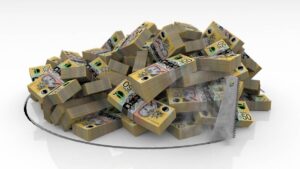Free Whelan’: Yield curve inversion? Yeah, there’s a trade for that

Pic: DKosig / iStock / Getty Images Plus via Getty Images
Sure as God wears sandals, there’s a few locks in the market that you always need to follow.
One of the most used phrases (and I’ve used it often) is that financials and insurers go up when rates go up.
Except, as pointed out by good friend to all, Callum Thomas of Topdown Charts, financials aren’t exactly responding how they should be.
What’s the go with… banks?
$KBE is a State Street ETF listed in the US that corresponds to the S&P Banks Select Industry Index.
It’s comprised mostly of regional US banks. I took a look at the KBE chart this week and what I saw wasn’t pretty.
Trading below the 200 Day Moving Average, MACD (moving average convergence divergence — a momentum indicator) crossing over to the downside below the 0-line, volume up on declining price.
For those less skilled in the ways of technical analysis, that’s… not bullish.
So, no. Things don’t always work on the old lines.
Yes, rising rates are great for financials but keep in mind that banks borrow short and lend long (put very simply) so if you borrow at the same rate (short term rates) as you’re lending (long term rates) and they’re both really close to each other then your margin is going to be a non-event.
Margins are everything to a bank. Margins are everything to every company.
That’s why in all things ahead you need to be sure you’re investing in companies that can maintain their margins in the face of all these things we have in front of us.
Supply chain, energy, wages etc. Those things smash a company’s margin.
Let’s talk about yield curve inversion
The yield curve is inverting at various points so everyone wants to have a good old freak out about it because it ALWAYS signals a recession.
Fact is, the inverting of the US 2/10 yield curve usually (on average of the last four inversions) buys:
– about 17 months until the peak;
– an average of 28.8% more gains until the peak;
– 21 months until the recession.
Comforting stats above come from @RyanDetrick, a wonderful Twitter follow and someone everyone should follow for these kinds of numbers.
Media boffins tell you a recession happens after an inversion, and they’re correct.
There’s not always the mention of the ~30% upside, though, for the most-watched market in the world (US stocks).
Everyone will tell you it’s different this time and they may be right.
However, with all of these headwinds put up in front of us the market has carried on regardless.
Speaking of things that are as certain as God wearing sandals, if Bill Ackman says the world is ending then you probably need to back the truck up and start buying.
Exhibit A, your honour:
In January 2020, I had nightmares about the potential for a pandemic, but everyone seemed to think I was crazy. I am having similar nightmares now. WWIII has likely started already, but we have been slow to recognize it. Putin has invaded Ukraine and it is not going well
— Bill Ackman (@BillAckman) March 6, 2022
Since that tweet, the S&P500 has risen by almost 10%.
My tongue is firmly in my cheek here, but the point is that it’s generally easier to be bullish.
People chasing headlines are not always on your side.
I hope the March quarter served you well and the next one will do just the same.
The US economy added 431,000 jobs last month and the unemployment rate is 3.6%. Australia is showing similar signs.
And yet every media outlet I talk to always wants to ask me about the downside…
All the best,
James
The views, information, or opinions expressed in the interview in this article are solely those of the writer and do not represent the views of Stockhead.
Stockhead has not provided, endorsed or otherwise assumed responsibility for any financial product advice contained in this article.
UNLOCK INSIGHTS
Discover the untold stories of emerging ASX stocks.
Daily news and expert analysis, it's free to subscribe.
By proceeding, you confirm you understand that we handle personal information in accordance with our Privacy Policy.








